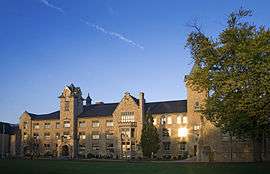Collegiate institute
A collegiate institute is a school of secondary education or higher education. The definition varies regionally, and the term has been largely unused outside Canada since the early 20th century.
Canada

In Canada, collegiate institute originally had a distinct meaning, but it has since transformed as a synonym for an institution that provides secondary education. In 1871, the province of Ontario set up two parallel secondary education systems.[1] Then, Galt Collegiate Institute was the first and one of only six schools in Ontario to have the name and privileges of being called a Collegiate Institute.[2] Collegiate institutes offered arts and humanities education, including Greek and Latin, for university-bound students. High schools offered vocational and science programs for those planning to enter the workforce upon graduation. The system was later adopted by other provinces, including Alberta, Manitoba, and Saskatchewan.
It was quite quickly realized that the division did not work very well. Over time, high schools responded to students' needs and increasingly offered the arts courses that were essential for the workforce. At the same time, as universities began teaching science and engineering, so did the collegiate institutes. Within a decade, the distinctions between the two systems were greatly blurred, and eventually, the two systems were merged in to a single secondary school system. In Ontario, after the merger of the two systems, the terms Collegiate Institute, High School, and Secondary School were all used in conjunction to refer to secondary educational institutions.
The term is most commonly found in Ontario, but its prominence varies throughout the province. In some school boards, including Lakehead District School Board, Toronto District School Board, and Waterloo Region District School Board, almost all secondary schools are named Collegiate Institute. Conversely, some school boards, like the Hamilton-Wentworth District School Board, have no secondary school with the term in its name. Most school boards in Ontario, however, continue to use all three terms (Collegiate Institute, High School, and Secondary School) in the names of their schools.
Although several Western Canadian provinces adopted Ontario's parallel school system (Alberta, Manitoba, Saskatchewan), there are far fewer schools in Western Canada that are known as collegiate institutes, with most having been closed or renamed over the decades. However, several secondary schools retain the term in their name, such as Lethbridge Collegiate Institute in Lethbridge, Alberta, and Mennonite Brethren Collegiate Institute in Winnipeg, Manitoba. In the cities of Saskatoon, and Regina, the term survives as Collegiate, which is found in the names of all public secondary schools and some Catholic secondary schools in those two cities. That contrasts the rest of Saskatchewan, where the most common name for secondary school is High School.
United States
.jpg)
In the United States, the term has largely fallen into disuse. Collegiate institutes in the United States were, for the most part, colleges, and even the first name of Yale University when founded in 1701 was a similar-sounding Collegiate School. But the definition of a college in the U.S. also differs from that of other countries, and has been primarily based on the liberal arts college model of higher education. Two examples of collegiate institutes in the United States before the term fell out of use are the Oberlin Collegiate Institute of Ohio, now Oberlin College,[3] and the Pentecostal Collegiate Institute of New York and Rhode Island, now the Eastern Nazarene College of Massachusetts.[4] Both were founded as postsecondary institutions (in 1833 and 1900, respectively), but the latter would drop its college curriculum and exist as a college preparatory school from 1902 until 1918, demonstrating the flexibility of the term collegiate institute. Partly because the term institute holds some ambiguity, many such schools would later change their names to use college instead of collegiate institute to more accurately represent their nature and mission, and the term "collegiate institute" would see little use beyond the early 20th century.
References
- ↑ The Cyclopædia of education by Henry Kiddle, Alexander Jacob Schem. Published by E. Steiger, 1876. p. 668.
- ↑ Region of Waterloo Public Building Inventory: Educational Buildings Part 2 (PDF) (Report). Region of Waterloo.
- ↑ Oberlin College Archives: Historical bibliography
- ↑ Cameron, James R. (1968). Eastern Nazarene College—The First Fifty Years, 1900-1950. Kansas City: Nazarene Publishing House.